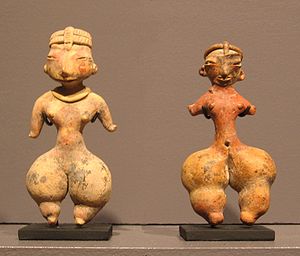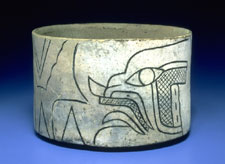
Tlatilco culture
Encyclopedia

Culture
Culture is a term that has many different inter-related meanings. For example, in 1952, Alfred Kroeber and Clyde Kluckhohn compiled a list of 164 definitions of "culture" in Culture: A Critical Review of Concepts and Definitions...
that flourished in the Valley of Mexico
Valley of Mexico
The Valley of Mexico is a highlands plateau in central Mexico roughly coterminous with the present-day Distrito Federal and the eastern half of the State of Mexico. Surrounded by mountains and volcanoes, the Valley of Mexico was a centre for several pre-Columbian civilizations, including...
between the years 1250 BCE
Common Era
Common Era ,abbreviated as CE, is an alternative designation for the calendar era originally introduced by Dionysius Exiguus in the 6th century, traditionally identified with Anno Domini .Dates before the year 1 CE are indicated by the usage of BCE, short for Before the Common Era Common Era...
and 800 BCE, during the Mesoamerica
Mesoamerica
Mesoamerica is a region and culture area in the Americas, extending approximately from central Mexico to Belize, Guatemala, El Salvador, Honduras, Nicaragua, and Costa Rica, within which a number of pre-Columbian societies flourished before the Spanish colonization of the Americas in the 15th and...
n Early Formative period
Mesoamerican chronology
Mesoamerican chronology divides the history of pre-Columbian Mesoamerica into several periods: the Paleo-Indian , the Archaic , the Preclassic , the Classic , and the Postclassic...
. Tlatilco
Tlatilco
Tlatilco was a large pre-Columbian village in the Valley of Mexico situated near the modern-day town of the same name in the Mexican Federal District. It was one of the first chiefdom centers to arise in the Valley, flourishing on the western shore of Lake Texcoco during the Middle Pre-Classic...
, Tlapacoya
Tlapacoya (Mesoamerican site)
Tlapacoya is an important archaeological site in Mexico, located at the foot of the Tlapacoya volcano, southeast of Mexico City, on the former shore of Lake Chalco. Tlapacoya was a major site for the Tlatilco culture....
, and Coapexco are the major Tlatilco culture sites
Archaeological site
An archaeological site is a place in which evidence of past activity is preserved , and which has been, or may be, investigated using the discipline of archaeology and represents a part of the archaeological record.Beyond this, the definition and geographical extent of a 'site' can vary widely,...
.
Tlatilco culture shows a marked increase in specialization over earlier cultures, including more complex settlement patterns, specialized occupations, and stratified social structures. In particular, the development of the chiefdom centers at Tlatilco and Tlapacoya is a defining characteristic of Tlatilco culture.
This period also saw a significant increase in long distance trade, particularly in iron ore, obsidian
Obsidian use in Mesoamerica
Obsidian is a naturally formed volcanic glass that was an important part of the material culture of Pre-Columbian Mesoamerica. Obsidian was a highly integrated part of daily and ritual life, and its widespread and varied use may be a significant contributor to Mesoamerica's lack of metallurgy...
, and greenstone
Greenstone (archaeology)
Greenstone is a common generic term for valuable, green-hued minerals and metamorphosed igneous rocks and stones, that were used in the fashioning of hardstone carvings such as jewelry, statuettes, ritual tools, and various other artefacts in early cultures...
, trade which likely facilitated the Olmec
Olmec
The Olmec were the first major Pre-Columbian civilization in Mexico. They lived in the tropical lowlands of south-central Mexico, in the modern-day states of Veracruz and Tabasco....
influence seen within the culture, and may explain the discovery of Tlatilco-style pottery near Cuautla, Morelos
Cuautla, Morelos
Cuautla , officially La heroica e histórica Cuautla de Morelos, or H. H. Cuautla de Morelos, is a city and municipality in the Mexican state of Morelos. In the 2005 census the city population was 145,482 and the municipality population was 160,285. The municipality covers 153.651 km²...
, 90 miles (144.8 km) to the south.
Defining the Tlatilco culture


Specifically, the Tlatilco culture is defined by the presence of:
- Both ritual and utilitarian ceramics.
- Both animal and human figurines rendered in a somewhat stylized manner.
- Clay masks and other exotic ritual objects.
- Elaborate burials with grave offerings.
- OlmecOlmecThe Olmec were the first major Pre-Columbian civilization in Mexico. They lived in the tropical lowlands of south-central Mexico, in the modern-day states of Veracruz and Tabasco....
-style decorations, motifs, designs, and figurines such as the hollow "baby-face" figurines or the pilli-style costumed males.
The Olmec influence is unmistakable. One survey of Tlatilco graves found that Olmec-style objects were "ubiquitous" in the earliest upper-middle status burials but were unrelated to wealth. That is, no correlation was found between the markers of high status and Olmec-style objects, and although larger numbers of Olmec-style objects were found in rich graves, they constituted a smaller percentage of the grave goods there.
Phases
Christine Niederberger BettonChristine Niederberger Betton
Christine Niederberger Betton, born in Bordeaux and deceased in 2001 in Mexico City was a French archaeologist. She is mainly noted for her contributions to the field of pre-Columbian American archaeology, in particular for her work on Mesoamerican cultures in central Mexico.-Early life:Christine...
, in her landmark 1987 archaeological study of the Valley of Mexico, identified two phases of the Tlatilco culture:
- Ayotla (Coapexco) phase, 1250 - 1000 BCE
- Manantial phase, 1000 - 800 BCE.
The Olmec-style artifacts appear suddenly, abundantly, and pervasively in the archaeological record at the outset of the Ayotla (Coapexco) phase.
At the end of the Ayotla, however, around 1000 BCE, there is another abrupt change in ceramics: figurines of costumed males give way to those of nude females, and Olmec-derived iconography evolves into a more native appearance, changes likely reflective of a change in religious ideas and practices.
By 800 BCE, the hallmarks of the Tlatilco culture fade from the archaeological record. By 700 BCE, Cuicuilco
Cuicuilco
Cuicuilco is an important archaeological Mesoamerican Middle and Late Formative period site located on the southern shore of the Lake Texcoco in the southeastern Valley of Mexico. Today, it is a significant archaeological site that was occupied during the Early Formative until its destruction in...
had become the largest and most dynamic city in the Valley of Mexico, eclipsing Tlatilco and Tlapacoya.

